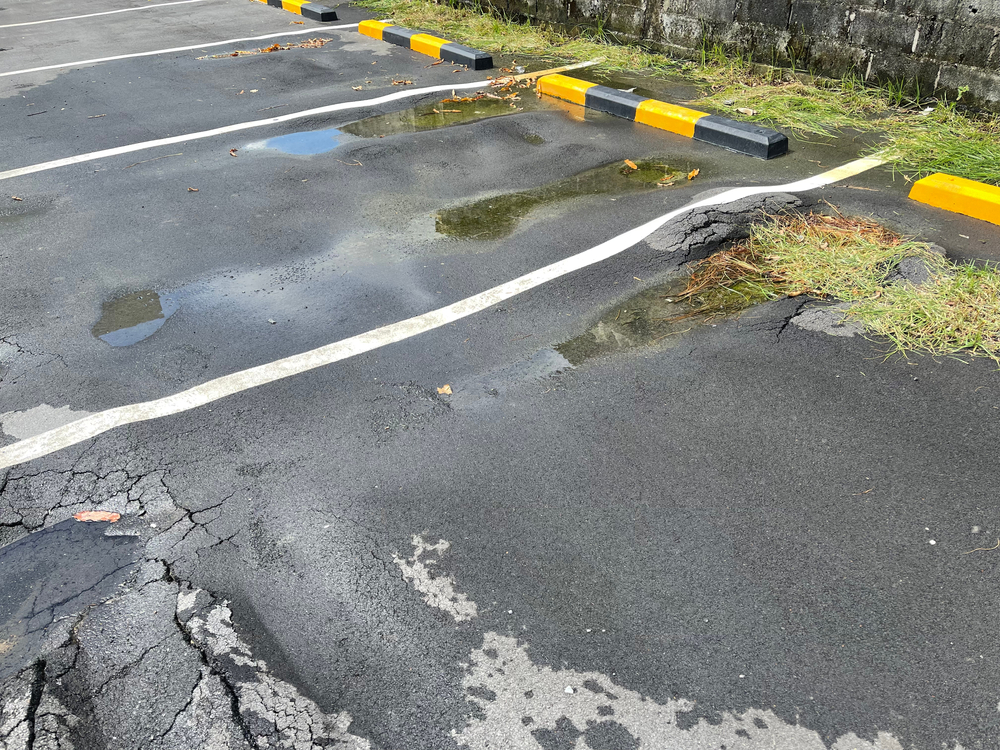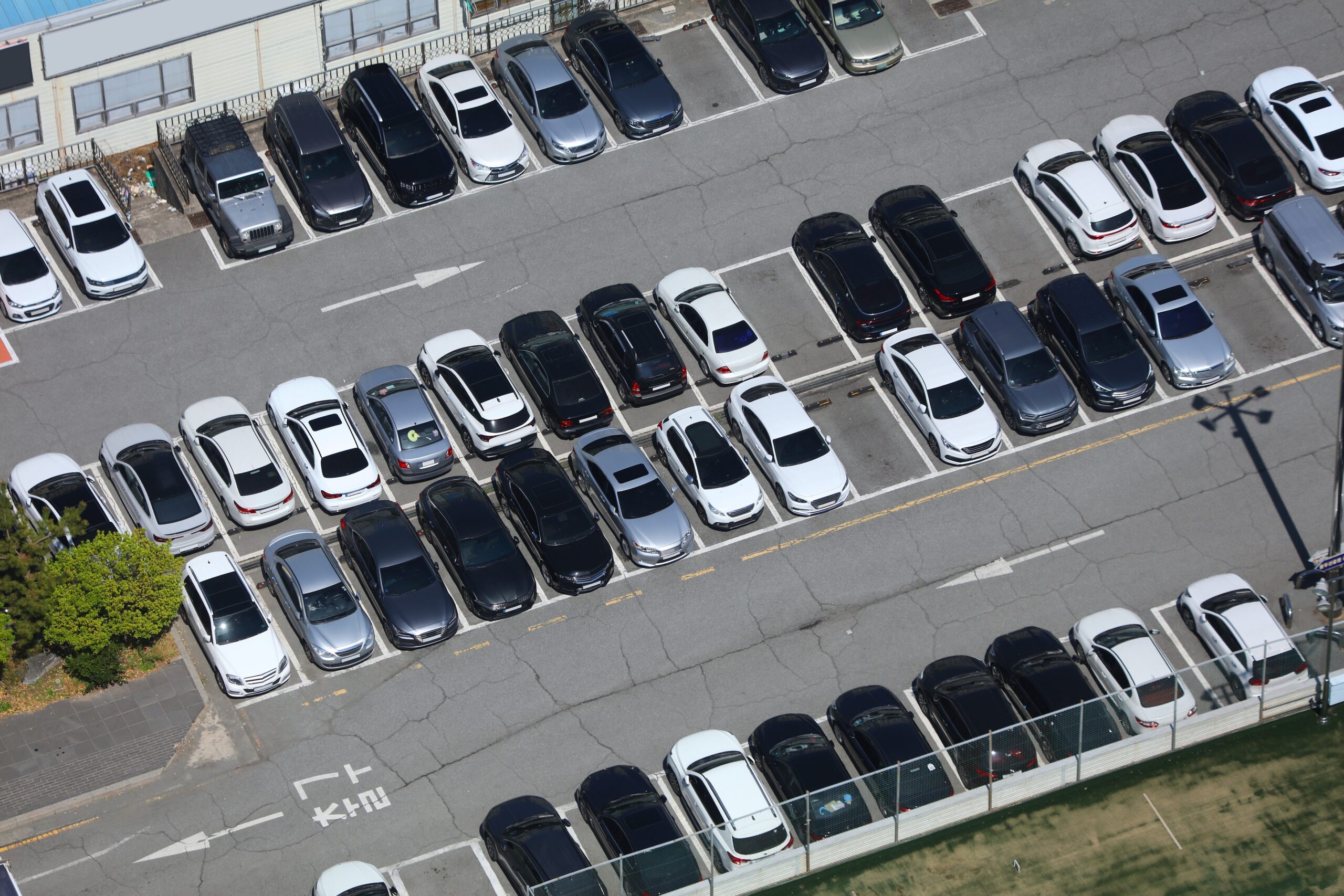
It’s easy to overlook a few small cracks in your parking lot. After all, how much harm could they do?
But here’s the truth: those cracks aren’t just surface issues. Over time, they allow water, oil, and chemicals to seep in, damaging the pavement underneath and releasing harmful pollutants into the environment. Left unchecked, what starts as minor wear can lead to soil contamination, polluted stormwater, safety hazards, and costly repairs.
The good news? With proper maintenance and timely repairs, you can protect your property, reduce long-term expenses, and prevent environmental harm. In this article, we’ll break down the real ecological effects of ignoring parking lot damage and how you can fix it before it’s too late.
Common Types of Parking Lot Damage That Harm the Environment
Not all damage looks serious at first, but even minor wear can quietly harm the environment if left unaddressed. Recognizing different types of parking lot damage early on can help prevent long-term pollution, costly repairs, and surface failure.
Here are the most common damage types that lead to environmental issues:
1. Surface Cracks (Alligator, Block, and Edge Cracks)
These are among the first signs of pavement wear. Cracks may seem small, but they allow:
- Water, oil, and chemicals seep beneath the surface.
- Pollutants can reach the soil and groundwater.
- Wider cracking and base failure over time
If ignored, these cracks quickly grow and multiply. Alligator cracking, which resembles reptile skin, indicates significant structural issues, while block cracks and edge cracks typically result from weather exposure and inadequate drainage.
2. Potholes
Potholes form when water enters through cracks, freezes, expands, and breaks apart the surface. They don’t just create driving hazards; they:
- Collect oil, antifreeze, and other vehicle fluids.
- Trap standing water to prevent it from becoming a breeding ground for pollutants.
- Accelerate asphalt breakdown, making repairs more expensive.
Potholes are also a major contributor to polluted stormwater runoff, especially in commercial parking areas with high traffic.
3. Ruts and Depressions
These are low spots in the asphalt where vehicle tires repeatedly pass or park. Ruts may seem harmless, but they:
- Hold rainwater, which carries surface contaminants.
- Encourage the removal of standing water, a key factor in asphalt weakening.
- Increase pollutant buildup in low-drainage areas.
Left untreated, these areas promote faster surface wear and higher environmental risks.
4. Oxidation and Raveling
As asphalt ages, UV rays and oxygen break down its binding agents. This causes oxidation, leading to:
- A brittle, faded surface
- Loosened aggregates (called raveling)
- Increased dust and particle release into the air and storm drains
Raveling is especially harmful because it weakens the top layer, allowing contaminants to travel faster into cracks and surrounding soils.
Environmental Risks of Damaged Parking Lots
Parking lot damage doesn’t just harm the pavement; it also affects the environment in more ways than most property owners realize. Cracked asphalt and neglected surfaces allow toxins to spread, raise local temperatures, and disrupt natural systems. Here’s how ignoring these issues creates long-term environmental problems:
1. Pollutants Leak Into Soil and Water
Damaged asphalt opens the door for dangerous substances to enter the ground. Oil leaks, fuel spills, antifreeze, heavy metals, and trash settle into the cracks and gradually seep downward.
This leads to:
- Soil contamination: harming plants and tree roots
- Groundwater pollution: impacting water supplies
- Stormwater system overload: sending untreated waste into streams and lakes
These pollutants don’t go away on their own. Once in the soil or water, they can affect ecosystems and human health for years.
2. Runoff Carries Toxic Chemicals Into Waterways
Rain doesn’t clean parking lots; it moves pollutants around. When rainwater flows across a damaged lot, it picks up:
- Oil and grease
- Tire particles
- Brake dust
- Chemicals from sealants
If your lot uses outdated seal coating (such as coal tar), runoff can include PAHs (polycyclic aromatic hydrocarbons), highly toxic and long-lasting chemicals. These pollutants enter storm drains and flow straight into rivers and lakes, where they:
- Kill fish and aquatic organisms.
- Contaminate sediments
- Lower overall water quality
Urban runoff from neglected lots is a significant source of pollution in city water systems.
3. The Heat Island Effect Intensifies
Cracked, old asphalt absorbs more sunlight than smooth, well-maintained pavement. This extra heat doesn’t just sit there; it radiates back into the air, increasing local temperatures. This phenomenon is known as the urban heat island effect.
The result?
- Higher energy use for cooling nearby buildings
- Increased stress on local trees and wildlife
- Poor air quality due to elevated surface temperatures
Proper parking lot maintenance (like seal coating and resurfacing) reflects more sunlight, keeping surfaces cooler and reducing energy use.
4. Damaged Lots Attract Dust, Debris, and Litter
When cracks and potholes go unchecked, they collect:
- Dust
- Trash
- Standing water
- Animal waste
This renders your lot an unsanitary space, harming nearby plants, attracting pests, and even exacerbating air pollution on dry days. Clean, sealed surfaces resist this buildup, helping your property stay clean and eco-friendly.
Environmental & Structural Risks of Ignoring Damage
Ignoring parking lot damage not only harms the surface but also creates significant environmental, structural, and legal risks. When left untreated, minor problems grow into major threats to your property, your community, and your business reputation.
Here are the most pressing risks caused by neglecting damaged asphalt:
1. Stormwater Pollution
Cracked and worn parking lots allow polluted rainwater to drain directly into storm sewers. This runoff often contains:
- Motor oil and grease
- Trash and debris
- Heavy metals and toxic chemicals
Since the water isn’t filtered, it flows straight into streams, rivers, and lakes, damaging aquatic ecosystems and introducing long-lasting pollutants. This is one of the leading causes of water pollution in urban areas.
2. Soil Damage and Plant Stress
When oil, fuel, or chemicals seep into the ground through open cracks, they contaminate nearby soil. This leads to:
- Weak or dying trees
- Stressed landscaping and patchy lawns
- Difficulty growing new plants around the property
Healthy soil is essential for curb appeal and property value. However, once it becomes polluted, restoration becomes costly and time-consuming.
3. Health Risks from Toxic Sealants
Many older parking lots use coal tar-based sealants, which are known to release polycyclic aromatic hydrocarbons (PAHs). These harmful chemicals:
- Become airborne during application and wear.
- Can be tracked indoors by foot traffic
- Are linked to respiratory issues, skin irritation, and even cancer
While newer sealants are safer, failing to maintain old coatings increases public health risks, especially for employees, customers, and nearby residents.
4. Liability and Safety Hazards
From a business and legal standpoint, ignoring pavement damage creates risks such as:
- Trip-and-fall accidents due to cracks or potholes
- Vehicle damage claims from uneven surfaces.
- Higher chances of lawsuits or insurance claims
These structural risks impact not only safety but also your brand reputation and liability exposure.
Eco-Friendly Maintenance & Repair Techniques
Maintaining your parking lot doesn’t have to harm the environment. Many modern asphalt repair methods are designed to protect natural systems while extending the life of your lot. Choosing the proper techniques not only saves money but also supports sustainability and local environmental health.
Here are the most effective eco-friendly asphalt maintenance and repair solutions:
1. Crack Sealing with Rubberized Fillers
Cracks are the first sign of wear and the easiest to fix. Sealing them early prevents water, oil, and chemicals from seeping into the base layers.
Why it’s eco-friendly:
- Prevents runoff pollution
- Stops moisture from expanding cracks
- Reduces the need for full resurfacing
Tip: Use hot rubberized sealants, which are long-lasting and flexible, perfect for high-traffic areas.
2. Pothole Patching
Potholes not only damage vehicles, but they also trap chemical-laden water, which can contaminate soil and stormwater systems. Fast repairs are critical.
Best practices:
- Clean out debris before filling
- Use eco-friendly cold-patch asphalt when possible.
- Compact thoroughly to prevent recurring damage.
Prompt patching reduces the spread of pollutants and restores safety.
3. Eco-Safe Seal Coating
Seal coating protects your pavement from sunlight, rain, oil, and chemical wear. But traditional coal tar sealants release high levels of toxins.
Eco-friendly alternatives:
- Low-VOC sealants
- Asphalt-emulsion coatings
- Bio-based formulas derived from natural materials
These options protect your lot without harming air or water quality.
4. Proper Drainage Systems
Water pooling on the surface accelerates wear and carries pollutants into the environment. Investing in innovative drainage solutions helps keep your lot clean and safe.
Recommended methods:
- French drains for underground water diversion
- Trench drains along sloped areas
- Proper grading to guide water toward safe runoff zones
Well-drained lots last longer and are less likely to pollute nearby areas.
5. Use of Sustainable Materials
Modern paving materials reduce environmental impact while maintaining durability.
Sustainable choices:
- Recycled Asphalt Pavement (RAP): Cuts down on landfill waste and reduces the need for raw mining
- Porous asphalt: Allows water to pass through, reducing runoff and improving stormwater filtration
These materials support LEED certifications and local green building standards.
6. Low-VOC and Bio-Based Sealants
For any sealant application, always look for:
- Low-VOC (volatile organic compounds) to reduce harmful fumes.
- Bio-based options made from renewable sources like plant oils
These options minimize the impact on air and water quality, especially in high-traffic commercial areas.
The Benefits of Timely, Green Maintenance
Taking quick action and using eco-friendly methods can save your parking lot and the environment. Here’s why it matters:
- Avoid Bigger Repairs: Sealing cracks early stops severe damage and costly rebuilds.
- Protect the Environment: Green materials and sealants reduce pollution and stormwater runoff.
- Improve Safety: Smooth, well-drained lots prevent accidents and injuries.
- Boost Curb Appeal: A clean, damage-free lot reflects a well-managed business.
- Extend Pavement Life: Regular upkeep adds years to your asphalt’s lifespan.
- Stay Compliant: Eco-friendly repairs help you meet local environmental standards.
Smart maintenance protects your budget, your brand, and the planet.
Frequently Asked Questions
Can parking lot cracks pollute water?
Yes. Even small cracks allow oil, fuel, and heavy metals to seep through the asphalt. These toxins can reach soil, storm drains, and eventually rivers, harming local ecosystems and water quality.
Are all sealcoats safe for the environment?
No. Traditional coal-tar sealants release harmful chemicals called PAHs (polycyclic aromatic hydrocarbons). Safer options include asphalt-emulsion or bio-based sealants that protect without polluting.
What’s the most eco-friendly repair method?
Crack sealing and green seal coating. Using recycled materials and low-VOC products helps reduce waste, minimize pollution, and extend pavement life while minimizing environmental harm.
How often should I inspect my parking lot?
Inspect quarterly. Also, check after extreme weather events, such as heat waves, storms, or freezing temperatures. Early detection prevents damage from spreading and avoids costly future repairs.
What is porous pavement, and why use it?
Porous pavement is a special material that allows water to pass through instead of pooling. It reduces runoff, filters pollutants, and helps recharge underground water supplies.
Make the Smart Move | Repair Before It’s Too Late
Minor parking lot issues can lead to severe environmental damage and costly repairs. Cracks allow oil and chemicals to seep into soil and waterways, while potholes and poor drainage increase safety risks. By acting early with eco-friendly maintenance, such as crack sealing, seal coating, and ensuring proper drainage, you can extend the life of your pavement and protect the surrounding environment.
Sustainable maintenance isn’t just smart; it’s good business.
Need help getting started? Contact Asphalt Coatings Company for expert, eco-conscious solutions that keep your lot durable, safe, and environmentally friendly all year round.



